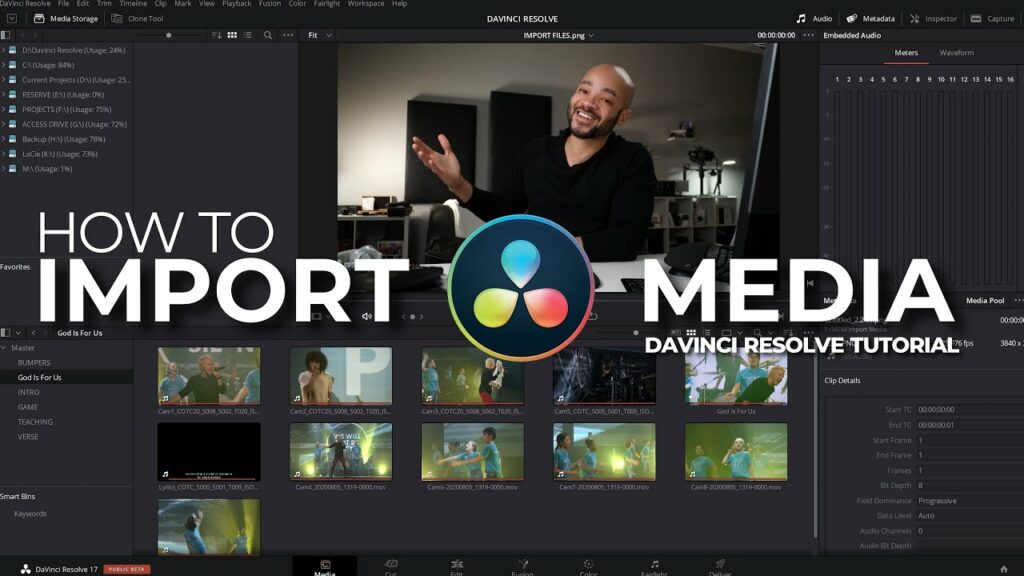Mastering Media Import: A Comprehensive Guide to Importing Media Files into DaVinci Resolve

Introduction:
Importing media files is the fundamental step in any video editing process, and DaVinci Resolve offers a robust set of tools for managing this crucial aspect of post-production. Whether you’re a seasoned professional or a novice editor, understanding the intricacies of importing media into DaVinci Resolve can significantly streamline your workflow and ensure a smooth editing experience. In this comprehensive guide, we’ll delve into the various methods, tips, and best practices for importing media files into DaVinci Resolve, empowering you to make the most out of this powerful editing software.
Understanding DaVinci Resolve Media Import:
Before diving into the practical aspects of importing media files, it’s essential to familiarize yourself with the underlying concepts and terminology within DaVinci Resolve’s media management system.
- Media Pool: The Media Pool serves as the central repository for all your media assets within DaVinci Resolve. It organizes your imported clips, images, audio files, and other media elements, making them easily accessible for editing.
- Supported File Formats: DaVinci Resolve supports a wide range of video, audio, and image file formats, ensuring compatibility with various cameras, recording devices, and creative assets.
- Metadata: Metadata contains essential information about your media files, such as resolution, frame rate, duration, and more. DaVinci Resolve utilizes metadata to categorize and manage your media assets efficiently.
Methods of Importing Media Files:
DaVinci Resolve offers multiple methods for importing media files, providing flexibility and convenience based on your preferences and workflow requirements. Let’s explore these methods in detail:
- Manual Import:
- Navigate to the Media Pool panel.
- Right-click within the panel and select “Import Media.”
- Browse to the location of your media files and select them for import.
- Click “Open” to import the selected files into your project.
- Drag and Drop:
- Simply drag media files from your file explorer or desktop directly into the Media Pool panel.
- DaVinci Resolve will automatically import the dropped files, organizing them within the Media Pool based on their file types.
- Import Media Dialog:
- Access the Import Media dialog by clicking on the “File” menu and selecting “Import Media.”
- Navigate to the location of your media files and select them.
- Customize import settings such as transcoding options, metadata handling, and more.
- Click “Import” to add the selected files to your project.
Best Practices for Efficient Media Import:
To streamline your editing workflow and maintain optimal organization, consider implementing the following best practices when importing media files into DaVinci Resolve:
- File Organization: Maintain a structured folder hierarchy for your media assets outside of DaVinci Resolve to facilitate easy navigation and access during import.
- Metadata Management: Ensure that your media files contain accurate and relevant metadata to aid in searchability and organization within DaVinci Resolve.
- Transcoding Considerations: Evaluate the need for transcoding media files to optimize performance or ensure compatibility with your editing system.
- Proxy Workflow: Implement proxy workflows for high-resolution media to enhance editing efficiency, particularly when working with resource-intensive formats or lower-powered hardware.
- Backup Strategies: Establish robust backup strategies to safeguard your media assets and project files against data loss or corruption.
- Collaboration Guidelines: If working in a collaborative environment, establish clear communication and file-sharing protocols to facilitate seamless media import and project collaboration.
Conclusion:
Importing media files into DaVinci Resolve is the crucial first step in any editing project, laying the foundation for the creative process that follows. By mastering the methods, techniques, and best practices outlined in this guide, you can streamline your workflow, optimize performance, and unlock the full potential of DaVinci Resolve as a comprehensive video editing solution. Whether you’re editing a short film, commercial project, or feature-length movie, efficient media import practices are essential for achieving professional results and delivering compelling visual storytelling.




